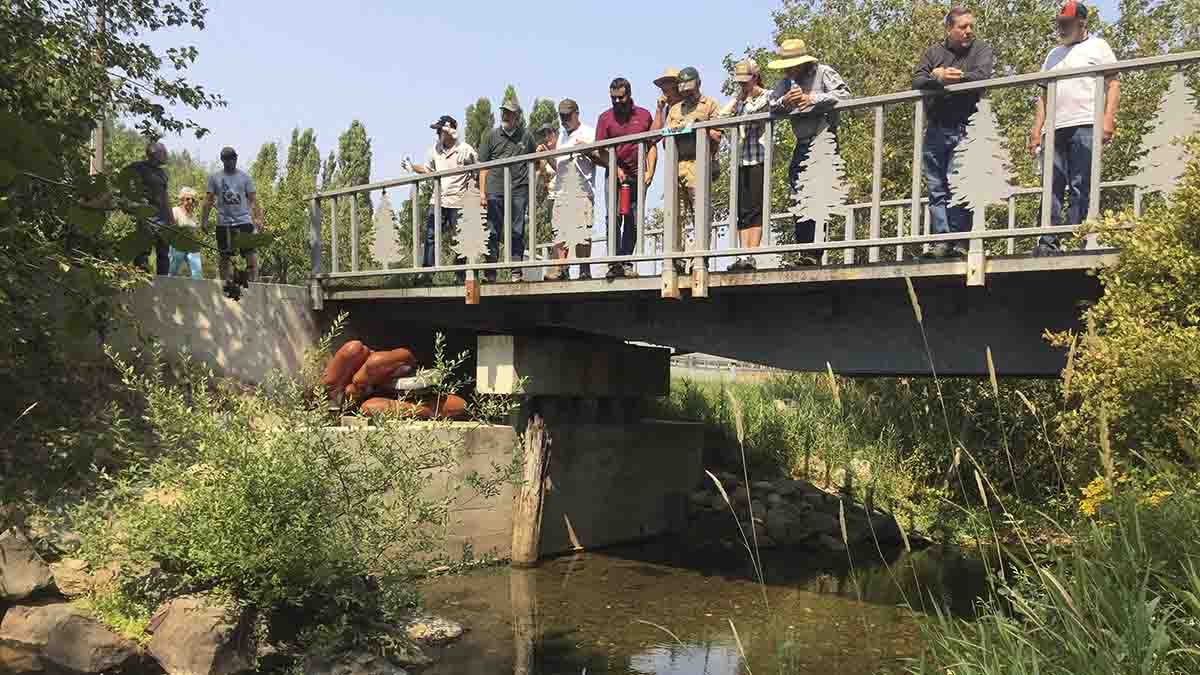Workshop Teaches Stream Restoration
January 24, 2024
A University of Idaho-led workshop is helping Idaho landowners transform eroding ditches running through their properties into scenic, riparian corridors that support a diversity of wildlife while capturing and storing water for agricultural use.
It was common practice in the late-1800s for Idaho landowners to straighten streams meandering through their valleys. Channelizing streams made farming easier but resulted in fast-moving flows cutting deeper and wider, drying the water table beneath adjacent marshland.
To remedy mistakes of the past, UI Extension forestry and water outreach programs have partnered with scientists and representatives from local agencies and nonprofits to offer a stream restoration workshop. The workshop — which has now been administered to more than 240 participants in five panhandle counties, plus Latah County — includes a half day of classroom training followed by field trips to stream reaches in various stages of restoration.
A survey of participants of past workshops found 83% intended to regularly monitor their stream health based on what they learned, 78% intended to implement actions to improve the health of one or more streams and 69% planned to work with professionals on stream restoration.
When streams are free to form natural bends and pools, water moves slower and with less erosive force, allowing it to deposit sediment and percolate into the soil, supplementing surrounding shallow water tables. Hay and other crops planted along healthy riparian corridors benefit from the moist soils.
“Nowadays we’re starting to try to slow that water back down again,” said Jim Ekins, UI Extension area water educator, who has run the program since 2018. “These valleys are drying out. Wells within them are drying out, and farmers are not getting a second cutting of hay.”
Organizers have set a goal of conducting at least one workshop in every northern Idaho county, with plans to host them in Clearwater and Benewah counties in 2024. They’re also willing to host workshops in other regions of the state where there’s interest.
Chris Schnepf, a UI Extension area educator specializing in forestry, started the workshop in 2015 with partial funding from an Idaho Department of Lands grant. Members of a focus group he assembled suggested Extension delve more deeply into water quality and stream programs.
Schnepf borrowed some of the workshop content from a six-week short course he teaches on water quality, as well as curriculum from the UI Extension Logger Education to Advance Professionalism (LEAP) program, which is designed to increase loggers’ understanding of forest ecology, silviculture and water quality.
“A lot of this becomes even more important in an era of changing climate where it’s really going to become more important for aquatic species such as trout and salmon and steelhead to be able to move around and find clean-water refuges,” Schnepf said. “A lot of habitat for trout and steelhead isn’t accessible because of barriers.”
Organizers recruit participants by checking where streams flow through private properties on GIS maps or finding addresses of properties with fish-bearing streams flowing through them at local assessors’ offices and sending mailers to the owners.
Workshop participants learn the basics of assessing stream health. An engineer with the U.S. Department of Agriculture’s Natural Resources Conservation Service (NRCS) presents on a range of stream-restoration approaches, ranging from sticking willow boughs along streambanks to take root to more costly stream makeovers involving engineering.
The workshop includes a discussion with a panel of experts from NRCS, local tribes, Idaho Soil and Water Conservation districts, the Idaho Department of Environmental Quality and other agencies. Workshop participants learn about cost-sharing opportunities and other resources that are available to help them implement their restorations.
“The newer way of doing things is using engineered logjams, introducing large organic debris into the stream to slow it down and using natural ways to armor the banks with roots and twigs and things like that,” Ekins said.
To learn more about the workshops, contact Ekins at 208-292-1287 or jekins@uidaho.edu.

About the University of Idaho
The University of Idaho, home of the Vandals, is Idaho’s land-grant, national research university. From its residential campus in Moscow, U of I serves the state of Idaho through educational centers in Boise, Coeur d’Alene and Idaho Falls, nine research and Extension centers, plus Extension offices in 42 counties. Home to nearly 11,000 students statewide, U of I is a leader in student-centered learning and excels at interdisciplinary research, service to businesses and communities, and in advancing diversity, citizenship and global outreach. U of I competes in the Big Sky and Western Athletic conferences. Learn more at uidaho.edu.






